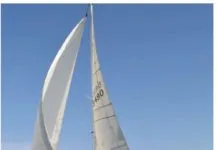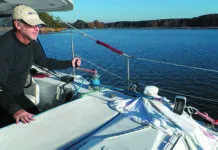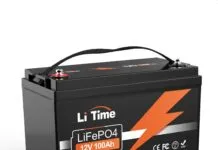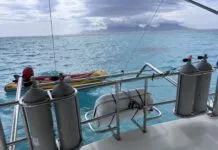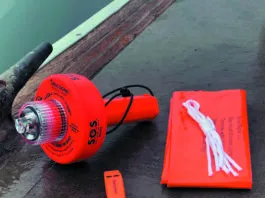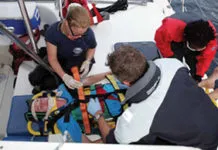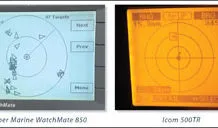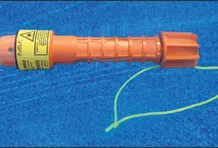Field Testing Drag, Behavior
We did not test every drogue that appears in the accompanying table, PS Value Guide: Drogues. However, we collected a huge amount of test data and observations from model testing and from multiple sources, including Victor Shanes Drag Device Database (www.dragdevicedb.com), and incorporated these into our test findings.
Which MOB Lights Shine Bright?
When a man-overboard (MOB) incident occurs at night, the odds of recovery become slimmer. The fate of the person in the water hinges on how fellow crewmembers respond and what the victim has intentionally or inadvertently taken with them into the water. A well-prepared offshore sailor will carry essential personal safety gear on him at all times while standing watch during a passage. At the top of the must-have list are a combination harness/inflatable personal flotation device (PFD) and a tether that can be clipped to a jackline to prevent you from being launched over the lifeline. (For an in-depth look at gear and techniques associated with an MOB incident, our downloadable e-book, Man Overboard Prevention and Recovery, is available through our online bookstore at www.practical-sailor.com/books.)
Stated Output Doesnt Always Match Real Life
Practical Sailors testing of man-overboard lights involved both lab and on-the-water testing. Our main interest was each lights brightness (radiance), but we also wanted to see how strobe patterns might hasten or delay the recovery of a man overboard.
Can Portable Flashlights Serve as MOB Lights?
During our man-overboard light testing, we also looked into the effectiveness of using a waterproof flashlight as a man-overboard signal. Most offshore sailors already carry a compact flashlight or wear a headlamp during night watches-why not choose one that can do double-duty? A dual-purpose flashlight would be in some ways similar to a cellphone-a device designed primarily for everyday use, but also capable of serving a lifesaving role in the event of an emergency.
Beaming Down Satcom Surgeons
Telemedicine, the ability to remotely treat patients in far-flung corners of the world, was still in its infancy in 1998 when it was put to a highly publicized test aboard a storm-tossed sailboat in the Southern Ocean. Russian competitive sailor Viktor Yazykov was participating in the solo Around Alone Race. His boat was about 900 miles below the tip of South Africa when his rig began falling apart. While Yazykov was repairing a broken shroud, an elbow he had injured earlier in the race grew inflamed with infection.
Comparing Medivac Services
If your cruising plans include bluewater voyaging or sailing to the far-reaches of the world, then packing a first-aid kit and getting travel insurance may not be enough. Should you contract a company that offers tele-medical advice, air-ambulance, and remote evacuation contract services? To help you decide, Practical Sailor submitted questionaires to three medivac companies-Global Rescue, International SOS, and Remote Medical International-to find out what services are available and how to decide which suits your needs.
Comparing Class B AIS Transceivers
The popularity of Automatic Identification Systems (AIS) has grown exponentially in recent years. Lower costs have played a big hand in this; however, the primary driver remains boat owners looking to increase safety. Our latest evaluation compared Class B transceivers from two key players in the AIS market. From Icom, we tested the MA-500TR. New Zealand-based Vesper Marine submitted its WatchMate 850 for testing. We rated the products on AIS functions, control capabilities, user-interface, filtering capability, display quality, and screen visibility.
The ODEO Laser Flare
Like winning lottery tickets and accurate head shots during the zombie apocalypse, visual distress signals are one of those things you just can't have too many of. To meet safety and legal carry requirements, most sailors have handheld, pyrotechnic flares onboard, but these have some drawbacks. Pyrotechnic flares generate molten slag that can injure a user if not handled properly; they have a short burn time (less than 3 minutes for U.S. Coast Guard-approved flares); and can be used only once. Also, they have a 42-month service life, so replacing them can add up, and they are made of hard-to-dispose-of hazardous materials.
Marine Handheld VHFs Test
Testers evaluated handheld VHF radios from three leading marine electronics makers. From Icom, we tested the M92D and M24. Standard Horizon submitted the HX290, HX300, and HX400, and from Midland Radio, we reviewed the Nautico 2. The VHFs in our test group ranged in price and features from a $50 basic, budget-friendly model to a $299, feature-rich handheld with DSC and GPS capabilities. All offered channel scanning, channel 16 quick select, NOAA weather radio, and weather alert. Unique features among the group included scrambler capabilities and remote microphone options.
Practical Tips for Survival at Sea
In the course of writing five books about accidents and survival at sea, Michael Tougias interviewed many survivors who shared with him the things they would have done differently, as well as what helped them survive. They did this to help prevent accidents and to help those who find themselves in trouble. Their tips and insights include decisions taken before the trip, actions taken when disaster strikes, and choices made during search and rescue. Add their insights to your survival-at-sea arsenal.


